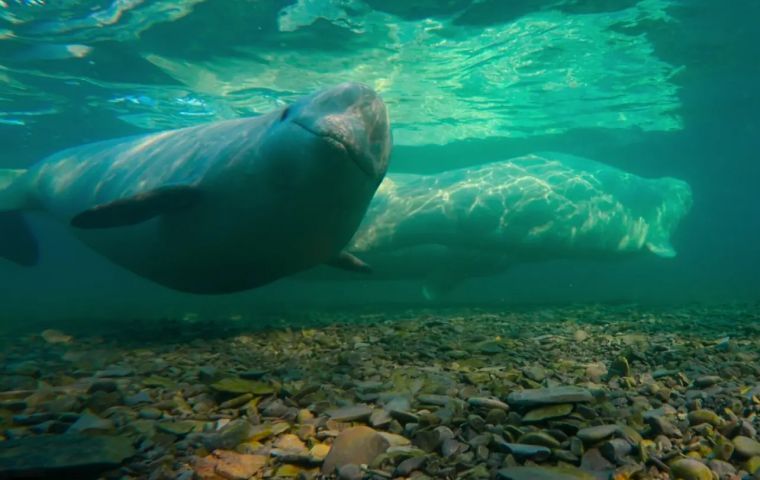MercoPress. South Atlantic News Agency
A must see, ‘Our Oceans,’ a Bewitching Natatory Experience narrated by Barack Obama
 Images are courtesy of Netflix
Images are courtesy of Netflix The following article, written by Chiara Spagnoli Gabardi for CinemaDailyUS refers to the spectacular Netflix film on “Our Oceans”, which is a must see.
The five-part Netflix series “Our Oceans” is executive produced by James Honeyborne, Michelle Obama and Barack Obama, and narrated by the latter. The voice of the 44th President of the United States narrates what life is like in our oceans: Pacific, Indian, Atlantic, Arctic and Southern.
Five filmmakers have curated each episode: Rachel Scott, Joe Tuck, Nick Lyon, Caroline Menzies, Abraham Joffe. There’s a distinct storyteller for each ocean, and yet there is no palpable difference in the way it all flows harmoniously. Our Oceans takes viewers on a 75,000-mile cruise across the aquatic world, thanks to cutting-edge research and newly developed underwater filmmaking technology that captures the intimate stories of the most magical, resourceful, and compelling creatures on our planet.
Every level beneath the vast canvas of blue is inhabited, and we get acquainted with extraordinary marine species. There’s an enchanting dimension populated by invertebrates. Comb jellies are the most ancient lineage of aquatic creatures. They are the greatest survivors, since they are the first multicellular organisms that evolved in the ocean that appeared on our planet more than 600 million years ago, giving rise to all animals alive today. Then there are species that resemble human engineers for the meticulous way in which they construct their homes to protect their future family, i.e. the eggs they will hatch. They display remarkable masonry skills.
Leaping dolphins roam freely through the warm shallows of Australia, whilst in the Falkland Islands the relentless winds push the algae around, instilling a rich green nuance to the ocean beds. Besides the visual enchantment, the marine realm is characterized by sounds, the ones aquatic mammals use to communicate, that determines their echolocation.
Many are the wanderers of the sea realm that traverse it far and wide for different reasons. For instance, motherhood is embodied by the humpback whale who has travelled 3000 miles to give birth. There are also species that seem to be born out of mythology and fairytales, such as the unicorn of the oceans: the Narwhal. This toothed whale stands out through its males that possess a long, spiralled tusk, which is also a highly innervated sensory organ.
Our Oceans also enlightens audiences on the most powerful circulation on Earth: the Global Ocean Current, that links diverse ecosystems into one giant life force, fuelling existence as we know it. This thousand-year occurrence, also known as the ‘conveyer belt,’ is a constantly moving system of deep-ocean circulation driven by temperature and salinity.
This Netflix experience allows you to dive deep into a watery macrocosm, and discover it one microcosm at a time. The force of the Earth’s rivers combined is found in the Gulf Stream, in the waters where the plankton blooms. Whilst in another ocean, floating stones are a sign of an undersea volcano erupting, releasing millions of minerals and nutrients. Moving further below the waves, tropical reefs feast through a coral carnival where a magical light show is staged by the ostracods, the tiny crustaceans that are by far the most common arthropods in the fossil record.
Besides the creatures who only live in water, there are also those who populate this environment, but also interact with the world above. There are Brünnich’s guillemots, seals, puffins, penguins, even polar bears that witness the change of the climate crisis caused by human beings. A blatant demonstration of this situation is represented by the way ice is transforming into slush. Dynamics between species are also morphing because of this, through cat-and-mouse games that have been ongoing for generations, where the rules are suddenly changing and the stalker becomes the stalked.
If on one side we are beguiled by the beauty of natatory nature, on the other side we witness how the oceans hold evidence of the throwaway lifestyle of the world above. Two million tons of plastic waste end up in these waters every year. Each piece takes hundreds of years to break down, becoming micro plastics, eventually making its way down in our food chain.
However the villains in this story — us — are not all despicable. Our Oceans shows that besides having caused damage to the aquatic world, mankind has come up with initiatives that help repopulate the wild. And yet, at the end of day, it is the other Earthlings that teach us humans the greatest lesson of all in the face of adversity: resilience and adaptation. Above all, when the wind rises and the stormy weather takes over, one should not fight it, but ride the wave, go with the flow and endure until peace and quiet return.


![“Working directly with President [Donald] Trump and Congress, we accomplished what no one else could,” Patel stressed](/data/cache/noticias/108417/130x80/fbi.jpg)

Top Comments
Disclaimer & comment rulesCommenting for this story is now closed.
If you have a Facebook account, become a fan and comment on our Facebook Page!